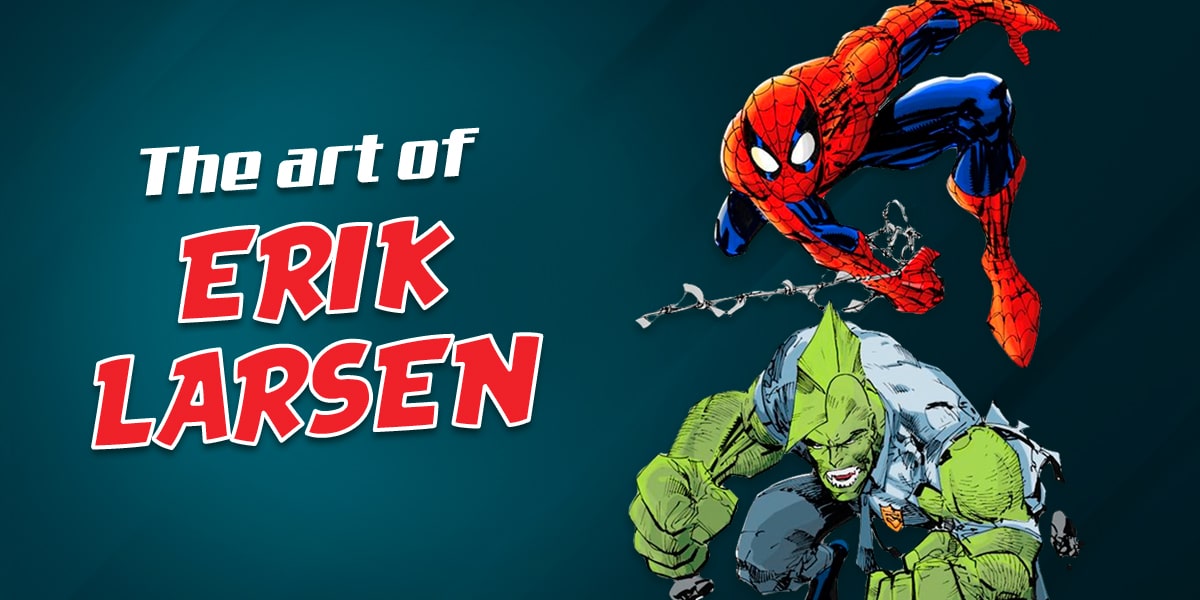Erik Larsen: The Wild Dragon of Comics
In the vast universe of comics, few names shine with the intensity and persistence of Erik Larsen. Tireless creator, bold innovator, and staunch defender of creative freedom, Larsen has left an indelible mark on the American comic industry. From his humble beginnings to becoming a pillar of Image Comics, his journey is a testament to passion, perseverance, and pure artistic talent. Join us on this journey through the life and work of one of the most influential and controversial artists in the world of comics.
From Dreamer Child to Independent Creator
Erik John Larsen was born on December 8, 1962, in Minneapolis, Minnesota, and grew up in Bellingham, Washington. From a very early age, comics became his passion, thanks to his father’s collection. His father, a university professor of English and literature, had a collection spanning from the dawn of the Golden Age to the controversial EC Comics magazines, which planted in young Erik the seeds of what would become a lifelong career.
As early as elementary school, Larsen was constantly drawing, creating hundreds of homemade comics with characters he invented by mixing his multiple influences. Among these early creations emerged The Dragon, a unique amalgamation of Batman, the Incredible Hulk, Captain Marvel, Speed Racer, and Captain Kirk. This character would become Larsen’s creative obsession, evolving along with his artistic style over the years.

In 1982, Larsen took a bold step: he drew a complete story of The Dragon and sent it to Charlton Comics. Although he received a rejection letter, this did not discourage him. Taking advantage of the desktop printer his father had bought, Larsen launched into self-publishing. Along with two other local artists, he produced Graphic Fantasy, a homemade comic with a print run of around 300 copies. Want to take your first steps in the world of comics? Discover how to start here.

This initiative not only demonstrated Larsen’s determination but also opened unexpected doors. A copy of Graphic Fantasy reached Gary Carlson, another self-publishing pioneer, who offered Larsen his first professional job: writing and drawing Vanguard for the Megaton anthology.
Rise in the Mainstream Industry
The work in Megaton was a springboard for Larsen. Although the publication was irregular, it allowed him to polish his style and gain visibility. Larsen began to combine realistic elements from popular artists like John Byrne and George Perez with his own cartoonish style, a fusion that would become his trademark.

Tireless in his pursuit of opportunities, Larsen sent samples of his work to anyone who would accept them. His perseverance paid off when, at the 1985 Chicago Comic-Con, Jim Shooter, editor-in-chief of Marvel Comics, assigned him a Hulk versus Thor story. Although this story took a while to be published, it opened the doors of Marvel and DC for Larsen, who began working on titles such as Amazing Spider-Man, New Teen Titans, and Adventures of Superman.
In 1987, Larsen reached another milestone in his career by obtaining his first regular series: Doom Patrol for DC Comics. Although the change in style was not well received by all fans, Larsen took advantage of this opportunity to refine his art and narrative. Click here to explore advanced visual storytelling techniques.

The Spider-Man Era and the Birth of Venom
The big leap in Larsen’s career came in 1989 when he was chosen to succeed Todd McFarlane as the regular artist for Amazing Spider-Man. Aware of the challenge of following such a beloved artist, Larsen immersed himself in studying Steve Ditko’s classic comics to capture the essence of the wall-crawler.

Larsen’s style proved to be a perfect complement to the new era of Spider-Man. His skills in drawing foreshortening and his sense of narrative took the hero’s acrobatics to new levels of dynamism. But perhaps his most memorable contribution was his redefinition of Venom, the alien symbiote that had become one of Marvel’s most popular villains.

Larsen took Venom to new extremes of monstrosity, exaggerating his musculature, elongating his fangs, and adding his iconic prehensile tongue. This version of Venom became the definitive one, influencing all subsequent representations of the character. Passionate about character design? Perfect your skills here.
Frustration and Revolution: The Birth of Image Comics
Despite his success at Marvel, Larsen felt increasingly frustrated with the company’s creative limitations and editorial structure. In an anonymous letter published in Comics Buyer’s Guide in 1991, Larsen harshly criticized the industry for its treatment of artists and the lack of opportunities for artists to write their own stories.

This frustration shared with other star artists of the time led to a historic moment in the comic industry. In 1992, Larsen joined Rob Liefeld, Todd McFarlane, Marc Silvestri, Jim Lee, and Jim Valentino to found Image Comics, a publisher based on creative independence and respect for authors.
The Savage Dragon: A Life’s Work
With the freedom provided by Image Comics, Larsen decided to dedicate himself to his most personal project: The Savage Dragon. This character, which he had been developing since childhood, finally had the opportunity to shine in his own series.

The Savage Dragon quickly stood out among Image’s launches for its solid narrative and character development. Larsen combined the typical action and excitement of Jack Kirby with a good dose of violence in keeping with the times, creating a comic that captured readers’ attention and has maintained it for decades. Enter here to learn how to create stories that hook your readers.

Over the years, Larsen has used The Savage Dragon as a field of experimentation, playing with different formats and narrative styles. From issues with all splash pages to experiments with panel layouts, Larsen has demonstrated tireless creativity and a constant desire to innovate in the medium.

The Continuing Legacy of Erik Larsen
Today, more than 250 issues later, Larsen remains dedicated to The Savage Dragon with the same passion as at the beginning. His commitment to the series and his constant innovation have made him a unique figure in the comic industry.
Larsen’s impact goes beyond his own work. As editor of Image Comics from 2004 to 2008, he played a crucial role in the publisher’s growth and in launching iconic series such as Robert Kirkman’s The Walking Dead.
Erik Larsen’s career is a testament to the importance of perseverance, creativity, and artistic integrity. From his humble beginnings to becoming one of the pillars of the comic industry, Larsen has shown that with passion and dedication, it is possible to create a work that endures over time.
For aspiring comic artists, Larsen’s story is a source of inspiration. It demonstrates that with hard work, determination, and a clear vision, it is possible to leave a lasting mark on the world of comics. Are you ready to start your own journey in the world of comics? Begin your adventure here.
Erik Larsen continues to be a creative force in the industry, always pushing the boundaries of what is possible in the comic medium. His legacy, both as an artist and as an advocate for creators’ rights, will continue to influence future generations of comic artists.



